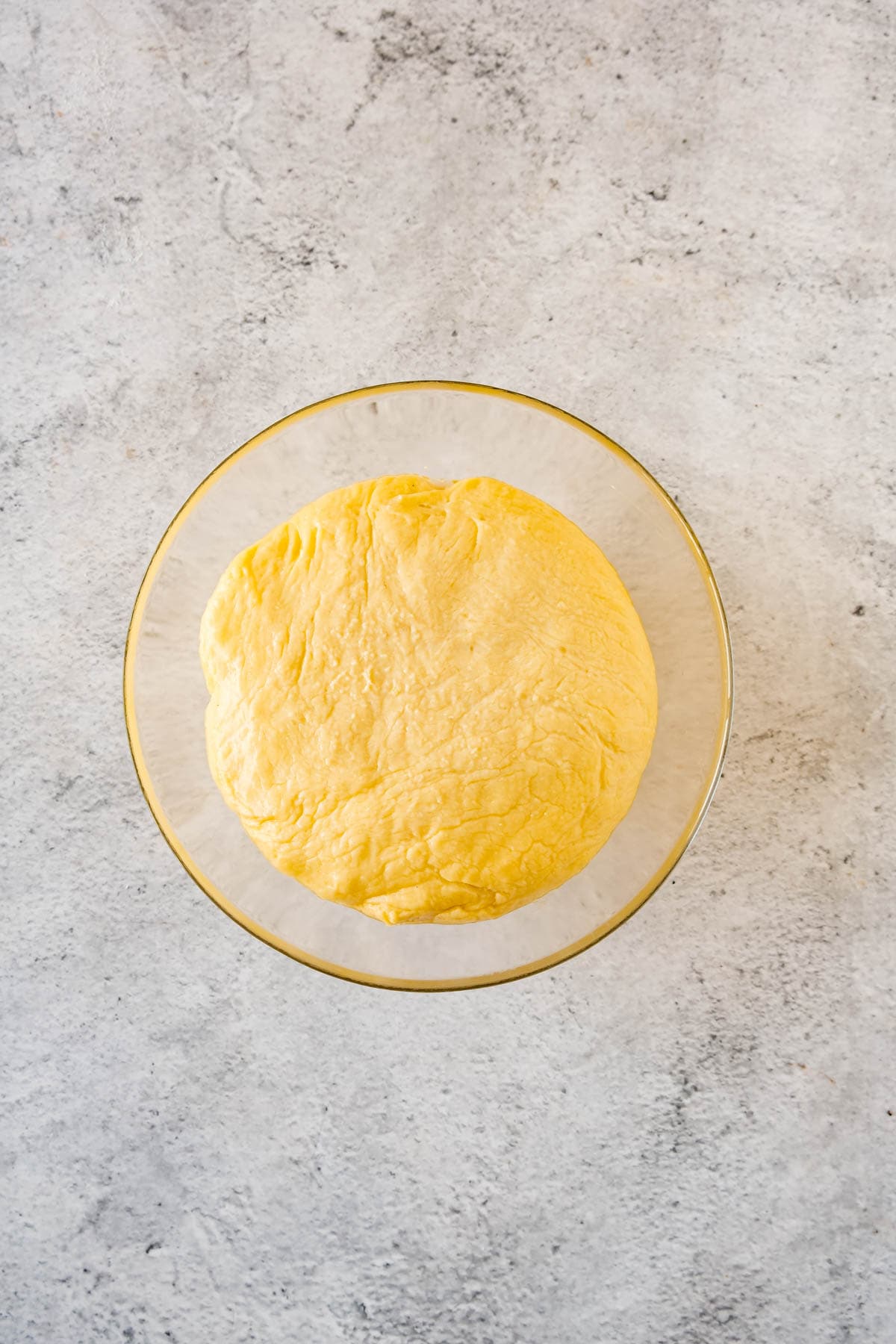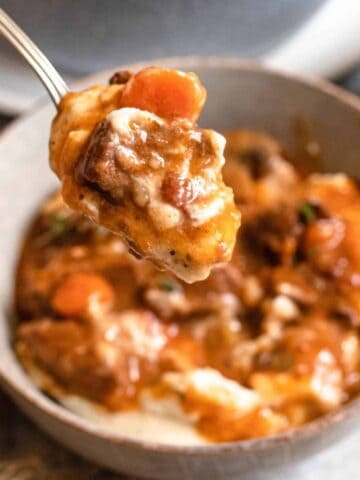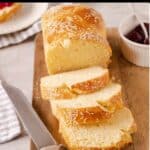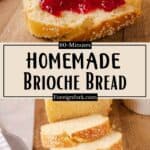Brioche is the perfect mix between bread and pastry. This recipe for Brioche Bread makes it easy to enjoy the light, fluffy, and buttery flavor of brioche at home.

Hello Reader! I try my hardest to research recipes as best as I can before posting to ensure I am representing each culture correctly. If this recipe is from your country and I have made a mistake or you have suggestions for how to make it more authentic, I would love to hear! Please leave a comment below letting me know what should be different, and I will rework the recipe. It is always my intention to pay homage and respect to each cultural dish that I cook. Thanks for reading!
I believe everything served on bread would be better served on brioche bread. Sandwiches, burgers, French toast, and even a smothering of jam become so much more delectable when delivered on this fluffy, flavorful brioche bread recipe.
Brioche is a French bread that is regarded as more of a pastry than a bread. Unlike French bread, made with very simple ingredients, brioche is made with an enriched dough that calls for eggs, sugar, and butter, which creates a very tender, fluffy bread with a soft crust.
All this extra fat changes the way the dough behaves and for some at-home bakers that change can be intimidating. However, brioche isn’t that hard to master at home.
This recipe simply calls for patience and perseverance. It takes time to knead the dough smooth and then more time to let it proof.
I promise, the result is worth the effort and once you master this delicious brioche loaf you’ll want to enjoy it every day!
For another delicious french recipe, don’t forget to try my Escargot Recipe from France!
Why Make This Recipe
- Simple Ingredients: Brioche bread is made with very basic ingredients. You don’t even need to buy any special flour for this recipe; all-purpose is just right for this buttery bread!
- Careful Instructions: There are several steps to achieving the perfect brioche bread. Just follow these directions carefully and you’ll be good to go!
- Amazing Results: This Brioche bread recipe is worth the effort if you want light, fluffy, flavorful, sweet bread. It works well with sweet or savory flavors and can be enjoyed in so many ways!
What Do You Need to Make This Recipe
Here is a visual overview of the ingredients in the recipe. Scroll down to the recipe at the bottom for quantities.

- Warm Milk: I recommend 2% or whole milk. You do not want to use skim as it will not have the fat you need for brioche. You also don’t want to use cold milk or hot milk. It needs to be just warm enough to activate your yeast but not too hot to kill it. The perfect temperature is between 100 – 110 degrees Fahrenheit.
- Active Dry Yeast: Be sure and check the expiration date on your yeast. You need fresh yeast to make this recipe work.
- All-Purpose Flour: You could use bread flour for brioche, but the higher protein content in the flour will result in a slightly chewier bread. All-purpose flour gives your brioche a nice soft crumb
- Eggs: This recipe calls for four eggs and an extra egg yolk. This is critical to a rich bread.
- Unsalted Butter: Allow your butter to soften at room temperature before using in your dough. Butter provides a rich flavor to the dough. Your softened butter should be around 68 degrees Fahrenheit.
- Sesame Seeds: These are optional for topping your bread!
Tools
- Large Mixing Bowl
- Stand Mixer with a Dough Hook Attachment
How to Make This Recipe
Step One: Activate the Yeast


Heat the milk on the stove or in the microwave for 35-40 seconds. The milk should not boil, try to keep the temperature between 100 – 110 degrees Fahrenheit. If the milk is too hot it will kill your yeast.
In a small bowl, add 1 Tbsp of granulated sugar to the milk along with the package of dry, active yeast.
Allow this to sit for 10 minutes or so to activate the yeast. Ensure that your yeast has risen before moving on to the next step.
Step Two: Mix Ingredients


In the bowl of a stand mixer, combine the dry ingredients: flour, salt, and remaining sugar. Mix to combine.
Add in the milk/yeast mixture as well as the beaten eggs (only use THREE eggs + 1 egg yolk for this step. The remaining egg will be used in an egg wash before baking). Using a spatula, stir the resulting mixture well. It will be sticky and soft.
Attach the dough hook and knead this dough on the lowest setting for about 5-6 minutes.
Add the softened butter to the dough. Add some butter, allow the mixer to incorporate it, then add the next round of butter. The whole process should take around 5 minutes or so.
Step Three: Knead

Once all of the butter is incorporated, put the mixer on medium speed and knead the dough for 10 minutes. If a large part of the dough remains on the edges of the mixer bowl, add 1-2 tbsp of flour.
The dough will be sticky, but you can easily remove it from the bowl using a silicone spatula. It should be soft and tacky to the touch, but should not stick to clean fingertips.
Step Four: Rest


Place the dough in a glass bowl, cover with a damp kitchen towel, and leave at room temperature for about 1 hour until doubled in size.
After the dough has doubled in volume, place it in the refrigerator for a second rise for at least 4 hours or up to 24 hours. This will make your bread soft and airy.
Step Five: Shape



Remove the dough from the refrigerator, punch it down several times, and divide it into 6 equal pieces. Shape the equal portions into balls. After kneading, flatten each of the small balls with your hands.
Arrange in a 10×5-inch loaf pan. Arrange the pieces of dough so that there is enough room for them to rise. Leave the dough at room temperature, covered, to rise for 1 ½ – 2 hours.
Step Six: Bake


Preheat the oven to 375 degrees Fahrenheit.
After the bread has doubled, crack the egg into a small bowl and add 1 tbsp of water. Whisk to combine. Use a pastry brush to brush the top of the bread with an egg wash. Sprinkle the dough with the sesame seeds.
Place the bread in the oven for 30-35 minutes or until you get a golden brown crust, the bread sounds hollow when you knock on it, and an internal temperature reaches 190 degrees Fahrenheit.
Allow the brioche loaf to cool for 10 minutes before removing it from the loaf tin. Then transfer to a wire rack to cool completely.
Serve and Enjoy!
Kneading by Hand
If you don’t have a stand mixer, you can knead the dough by hand, but be aware that your dough will not look like regular bread dough at first.
Transfer the dough from the bowl to a floured surface and knead it with your hands. It will be very sticky, so flour your hands well.
Add the butter and, with firm pressure on the counter, knead the dough to combine the ingredients and make a soft ball of dough that you can easily shape.
Tips for Rising Your Dough
If you live in a cold climate you may need some help from your oven to create a warm rising place for your brioche dough. The ideal rising temperature for dough is 75 to 78 degrees.
Most ovens can come to this temperature if you place your bowl inside and turn the light on. If you have an oven-safe bowl, you can also try letting the dough rise in the oven at 122 degrees Fahrenheit for 30-35 minutes or until doubled in size.
Knowing When Your Dough Is Ready
Your kneading time may vary. In the beginning, your dough will look more like batter. When your dough is fully kneaded it should be soft, and it should come out of the mixer easily with a rubber spatula.
Your brioche dough will be sticky but do not be tempted to add more flour. Too much flour will make your dough dry and your bread crumbly. Make sure when you measure your flour that you fluff it up, scoop gently, and use a knife to level off the top.
Expert Tips

- It is very important to use butter that is soft but not melted when preparing brioche bread. Allow it to soften at room temperature until you can easily leave a mark in it with a light press of a finger. This will help it incorporate into your dough fully. Your eggs will also incorporate better if they are at room temperature.
- The egg wash on the top of your loaf gives it a beautiful, shiny finish. You could skip it if you want but for truly beautiful brioche bread, do it!
How Can You Tell the Dough is Ready to Be Baked?
One danger with brioche is overproofing your bread. If you poke your bread and it deflates, your dough has been over-proofed, or left to rise for too long. This may cause it to deflate when you try to bake it or overflow from your pan.
To save it, reshape it just like you did in the beginning and let it rise again but for less time.
The dough is ready to bake when you poke it and the indent stays or rises back slightly. If it bounces back too quickly it may need more time to rise.
How to Serve this Brioche Bread Recipe

Brioche bread can be enjoyed in so many ways, both sweet and savory. It makes excellent toast, topped with jam or your favorite nut butter.
You could also use slices of brioche for a sandwich.
You can also use this same dough for buns for burgers, sliders, or even cinnamon rolls!
Can Brioche be Frozen?
Yes, brioche freezes very well. Wrap it in plastic wrap and store it in the freezer for up to three months. Let it thaw at room temperature to use or you can slice it before you freeze it and throw a frozen slice directly into the toaster to enjoy.
Why is My Dough so Sticky?
Brioche dough is not like French bread dough. It will be a very sticky dough, very soft, and at first seem almost impossible to work with. The magic happens as it is kneaded and the gluten is developed.
Kneading and rising are the most time-consuming parts of making brioche, but both are crucial to a truly delicious, fluffy bread.
Be patient with your kneading. You will know it’s done when you try to lift your dough and it easily comes away from the bowl without breaking. It should be shiny and smooth with no clumps or oiliness.
Another good test to see if your dough is ready is the windowpane test. Take a small piece of dough and stretch it in all directions. If it stretches to the point where you can almost see through it in the middle, like a window pane, it is ready to proof.
Stickiness is a good sign with this dough–don’t panic and add more flour! Give it at least 30 minutes of kneading before you add any more flour.
What Kind of Flour is Best for Brioche Bread?
All-purpose flour is a great choice for this brioche bread recipe. It has 10-11% protein, compared to 12-13% protein in bread flour. Higher protein means more gluten and more chewiness. Brioche is meant to have a more tender crumb so the lower amount of protein is just right for this type of bread.
You could substitute bread flour if you prefer chewier bread.
Did you like this French Brioche Bread recipe? If so, make sure to check out these other recipes we picked out just for you:

The Best Brioche Bread Recipe (for Beginners!)
Equipment
- Large Mixing Bowl
- Stand Mixer with a Dough Hook Attachment
Ingredients
- ¼ cup milk, 2% or whole
- 2 tbsp granulated sugar, divided
- 2 ¼ tsp active dry yeast
- 2 ¾ cups all purpose flour
- 1 tsp salt
- 4 eggs , beaten, + 1 egg yolk
- ½ cup unsalted butter, softened + cut into ½ tablespoon-sized pieces
- 1 tsp sesame seeds
Instructions
- Heat ¼ cup milk on the stove or in the microwave for 35-40 seconds. The milk should not boil, try to keep the temperature between 100 – 110 degrees Fahrenheit.
- In a small bowl, add 1 Tbsp of granulated sugar into the milk along with the package of dry, active yeast.
- Allow this to sit for 10 minutes or so to activate the yeast. Ensure that your yeast has risen before moving on to the next step.
- In the bowl of a stand mixer, combine the 2 ¾ cup flour, 1 tsp salt, and remaining 1 tbsp sugar. Mix to combine.
- Add in the milk/yeast mixture as well as the 3 beaten eggs (only use THREE eggs + 1 egg yolk for this step. The remaining egg will be used in an egg wash before baking). Using a spatula, stir the resulting mixture well. It will be sticky and soft.
- Attach the dough hook and knead this dough on the lowest setting for about 5-6 minutes.
- Add the ½ cup softened butter into the dough a few pieces at a time. Add some butter, allow the mixer to incorporate it, then add the next round of butter. The whole process should take around 5 minutes or so.
- Once all of the butter is incorporated, put the mixer on medium speed and knead the dough for 10 minutes. If a large part of the dough remains on the edges of the mixer bowl, add 1-2 tbsp of flour. The dough will be sticky, but you can easily remove it from the bowl using a silicone spatula. It should be soft and tacky to the touch, but should not stick to clean fingertips.
- Place the dough in a glass bowl, cover with a damp kitchen towel, and leave at room temperature for about 1 hour until doubled in size.
- After the dough has doubled in volume, place it in the refrigerator for at least 4 hours or up to 24 hours. This will make your bread soft and airy.
- Remove the dough from the refrigerator, punch it down several times, and divide into 6 equal parts. Shape the parts into balls. After kneading, flatten each of the balls with your hands.
- Arrange in a 10×5-inch loaf pan. Arrange the pieces of dough so that there is enough room for them to rise. Leave the dough at room temperature, covered, to rise for 1 ½ – 2 hours.
- Preheat the oven to 375 degrees Fahrenheit.
- After the bread has doubled, crack the last egg into a small bowl and add 1 tbsp of water. Whisk to combine. Use a pastry brush to brush the top of the bread with an egg wash. Sprinkle the dough with the 1 tsp sesame seeds.
- Place the bread in the oven for 30-35 minutes or until you get a golden brown crust, the bread sounds hollow when you knock on it, and an internal temperature reaches 190 degrees Fahrenheit.
- Allow the bread to cool for 10 minutes before removing it from the loaf tin. Then transfer to a wire rack to cool completely.
- Serve and Enjoy!
Notes
- Warm Milk: I recommend 2% or whole milk. You do not want to use skim as it will not have the fat you need. You also don’t want to use cold milk or hot milk. It needs to be just warm enough to activate your yeast but not too hot to kill it. The perfect temperature is between 100 – 110 degrees Fahrenheit.
- Active Dry Yeast: Be sure and check the expiration date on your yeast. You need fresh yeast to make this recipe work.
- All-Purpose Flour: You could use bread flour for brioche, but the higher protein content in the flour will result in a slightly chewier bread. All purpose flour gives your brioche a nice soft crumb
- Eggs: This recipe calls for four eggs and an extra egg yolk. This is critical to a really rich bread.
- Unsalted Butter: Allow your butter to soften at room temperature before using in your dough. Butter provides a rich flavor to the dough. Your softened butter should be around 68 degrees Fahrenheit.
- Sesame Seeds: These are optional for topping your bread!
- It is very important to use butter that is soft but not melted. Allow it to soften at room temperature until you can easily leave a mark in it with a light press of a finger. This will help it incorporate into your dough fully. Your eggs will also incorporate better if they are at room temperature.
- The egg wash on the top of your loaf gives it a beautiful, shiny finish. You could skip it if you want but for truly beautiful bread, do it!










Cire says
you don’t weigh your ingredients using a kitchen scale. Serious-minded amateur bakers increasingly weigh their ingredients; professional bakers in America have ALWAYS weighed their ingredients.
Alexandria Drzazgowski says
Hi Cire, yes I definitely agree that weighing ingredients can be helpful! Most Americans bake using imperial measurements, and because my audience is primarily Americans, that is why my recipes use imperial measurements as well.